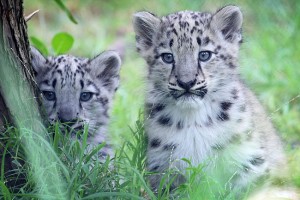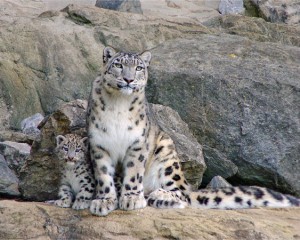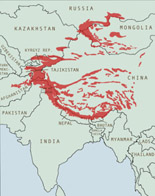Where do snow leopards live?
Snow leopards live in 12 countries in different parts of Asia. The countries are – Afghanistan, Bhutan, China, India, Kazakhstan, Kyrgyzstan, Mongolia, Nepal, Pakistan, Russia, Tajikistan and Uzbekistan.
Are snow leopards endangered?
Yes, there are not many snow leopards left in the wild. Because there are so few (between 3000-5000) it is not known if they will survive in their natural habitat.
Why are snow leopards endangered?
The biggest threat to snow leopards are humans. Humans hunt them for their fur and their bones. Fur to wear as coats and hats and bones to be used in traditional medicines. Humans also destroy snow leopard habitat and food sources by killing the prey animals (wild sheep and goats) they need to feed on.
What enemies does the snow leopard have?
Only humans.
What is the snow leopard’s scientific name?
Panthera Uncia.
How big are snow leopards?
Snow leopards are smaller than the big cats Like lions and tigers and generally weigh between 30 and 55 kilos (60 and 100 pounds).
 How have snow leopards adapted to live in their environment?
How have snow leopards adapted to live in their environment?
Their tail is long and thick and helps the cat keep itself warm as it wraps the tail around the body during sleep. Also the long tail helps the snow leopard keep balance as it races down rocks chasing prey like wild sheep and goats. The fur is long and thick to keep the snow leopard warm and its color of gray and white makes it almost impossible to see the cats on the rocks and in snow. They have very small ears so they don’t lose body heat from them. Their paws are very wide so it’s easier to walk in deep snow.
What altitude can snow leopards live at in the mountains?
In the Himalayan mountains snow leopards can be found up to 4000m (17,000 feet).
How cold does it get in snow leopard habitat?
In winter it can get minus 20-30 degrees centigrade where snow leopards live.
 What do snow leopards eat?
What do snow leopards eat?
Snow leopards will eat wild sheep and goats (like the ibex in photo left) and a little animal like a rabbit called a marmot. They will also occassionally eat birds. If they can’t get wild animals they will go to villages and kill sheep and goats belonging to the village.
How many cubs does a snow leopard mother have?
Between 1 and 5 cubs can be born to a mother but the most common number is two.
When and where are the cubs born?
Mating between snow leopards occurs in late winter, around January to March and the cubs are born in summer, June to July. The mother finds a rocky den to have the cubs.
 What do the cubs look like?
What do the cubs look like?
The cubs are very cute. At first they are very tiny and almost black. When they are born they can’t see. They open their eyes about 3 weeks after birth. They are not able to walk until about 4 weeks of age so the mother carries them in her mouth. The rosettes (the round marks on their fur) come at about 2 months of age.
At what age do the cubs leave the mother?
The cubs will stay with the mother until about 18 months of age. For the first four months she feeds them with milk, then they start to eat meat. After about 6 months she starts to teach them to hunt.
How old do snow leopards get in the wild?
If a snow leopard is not killed by humans it can live to between 9 and 11 years of age.
 For teachers
For teachers
Teaching children about endangered species is important because they are the future caretakers of the planet. Most children are captivated by animals like the beautiful snow leopard so using this cat, as a means to teach students about their planet can be highly motivating.
Students of any age can learn about endangered snow leopards and participate in conservation projects with parents and schools and friends. I’ve seen from comments and emails on this blog that you are never too young to make a difference.
“Engaging Students in Conservation: Protecting the Endangered Snow Leopard” is an interdisciplinary 1-2 week unit developed through a collaboration with the Snow Leopard Trust, M.J. Murdock Charitable Trust, and facing the Future.
Designed for USA 5-8th grade students in science and social studies this unit includes five dynamic lessons and culminates in a service-learning project. The unit introduces students to snow leopard facts about the animal and its ecosystem, explores human-wildlife conflicts in areas where snow leopard habitat is populated by local communities and helps students understand the importance and effectiveness of community-based conservation.




